Lawn Aeration Services
As a foundational piece of our organic lawn care program, Pure Solutions core aeration service promotes and sustains a beautifully natural and healthy lawn that will be the envy of all your neighbors.
Pure Solutions Organic Lawn Care Aeration Program
By coring soil plugs out of the lawn, this allows air, water, and nutrients to penetrate deeper into the soil. Helping to provide vital nutrients to the soil and alleviate compaction that occurs from mowing, walking, etc.

Phase 1
Using an efficient and accurate ride-on aerator, a Pure Solutions lawn care technician will mechanically remove small plugs of soil, turf and thatch from your organic lawn.
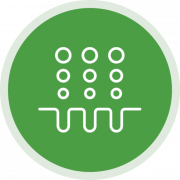
Phase 2
Our trained organic law care specialist will then overseed your lawn to take advantage of the ideal conditions for germination created by the aeration process. We use specialized seed varieties to provide the best possible germination possible.
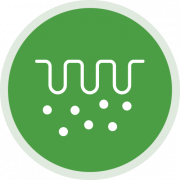
Phase 3
Over the course of about 2 weeks, the organic lawn core plugs will break down and provide valuable nutrients to your yard during a crucial time as we head towards winter.

Phase 4
New roots will begin to show in the aerated lawn holes. You may also see some late fall turf growth on your property, depending on weather conditions. Your all-natural lawn is now ready to hibernate for winter and its foundation is set to give it the best conditions for growth come spring.
Why You Should Make the Switch
- Every year millions of pounds of harmful, toxic pesticides are used across the United States on home lawns.
- According to the EPA, traditional lawn chemicals can put children and pets at risk.
- Healthy Organic lawns can help offset climate change by sequestering carbon dioxide.
- Organic lawns use less water.
- No leaching of chemicals into valuable drinking resources.
- Organic lawns are more stress tolerant.
Get a Digital Quote Today!
Help Your Lawn Eat, Breath, Grow and Flourish
One of the best practices you can provide to your property on a yearly basis is aeration and overseeding. The process of aeration helps reduce soil compaction, lets the turf roots breath, and brings new life to the turf stand after stressful summer weather.
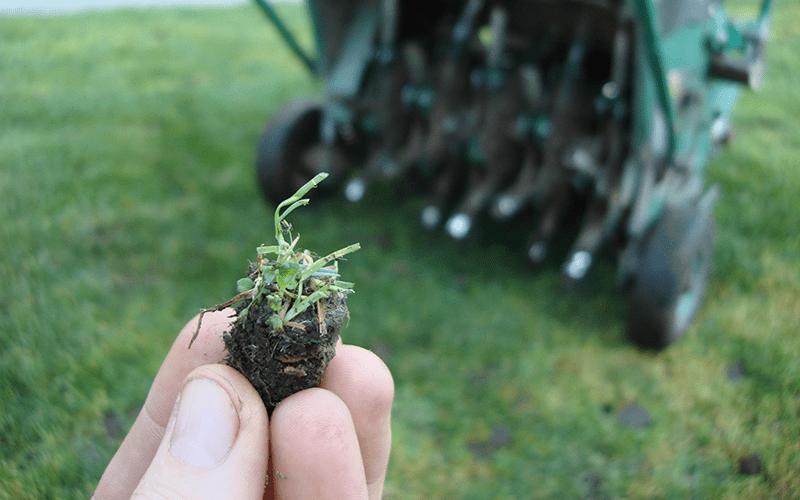
What is lawn aeration?
All lawns have a thatch layer which is the layer of decaying turf/grass between the crown of the plant and the soil The thatch layer makes it difficult for fertilizers and nutrients into the soil. Aeration utilizes a mechanical process to pull out a small ¾ inch core of soil throughout your lawn. At Pure Solutions, we leave behind the cores to decay and help feed the microbes in your organic lawn.
Why is aeration and overseeding commonly done together?
With our organic lawn care program, these services are performed together because the holes punched into the lawn when you aerate create a great place for seeds to come in contact with the soil increasing the time it takes seeds to germinate. The seed is also less exposed to the elements/pests etc. Additionally, the lawn aeration holes also stay damp longer, creating a better environment for seed germination.
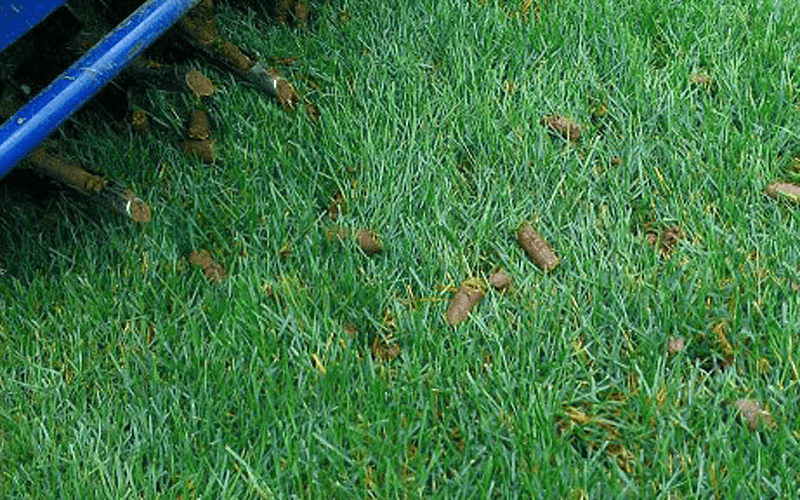
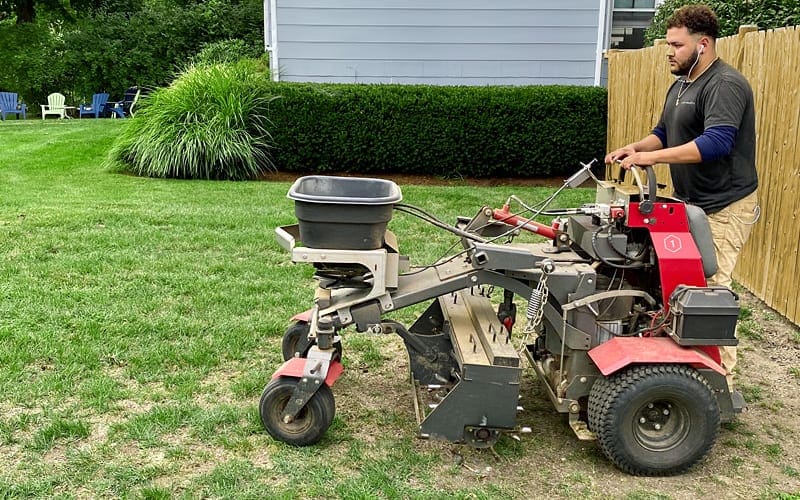
When is the best time to aerate an organic lawn?
We traditionally aim to aerate between the last 2 weeks of August up until the third week of October as part of our organic lawn care program. This is also when we overseed, because the soil temperatures are still warm from the summer but the daytime temperatures are not as warm allowing for optimal growth.
Frequently Asked Questions
How to aerate your lawn?
Aerating your lawn is an important aspect of lawn care that involves creating small holes in the soil to allow air, water, and nutrients to penetrate the grass roots. To aerate your lawn, you can use a manual or mechanical aerator that removes small plugs of soil or simply spikes the soil with hollow tines. Before aerating, make sure your lawn is moist but not waterlogged. Start by mowing your lawn to half its normal height and removing any debris or weeds. Then, mark any obstacles such as sprinkler heads or rocks to avoid damaging them during aeration. Move the aerator in straight lines across your lawn, overlapping each pass slightly to ensure even coverage. After aerating, leave the soil plugs on the lawn to decompose, or remove them if desired. Aeration is typically done once or twice a year, depending on the condition of your lawn and soil.
When should you aerate your lawn?
The best time to aerate your lawn in New England is during the growing season, which typically starts in early spring and lasts until early fall. For most parts of New England, the ideal time for aeration is in the fall, around September or October. Fall aeration allows the grass to recover before the dormant winter months and can help to prevent soil compaction caused by heavy foot traffic during the summer. Additionally, fall aeration can help to reduce thatch buildup, which can be a problem in New England lawns.
How often should you aerate your lawn?
The frequency of lawn aeration depends on various factors, such as soil type, grass type, and foot traffic. In general, it is recommended to aerate your lawn at least once a year, preferably in the spring or fall. If your lawn is heavily used, or if you have compacted soil, you may need to aerate it more frequently. Signs that your lawn needs aeration include poor drainage, thinning grass, and soil that feels hard or compacted.
What is lawn aeration?
Lawn aeration is the process of creating small holes in the surface of a lawn, typically using a tool called an aerator. The purpose of lawn aeration is to loosen compacted soil and to allow air, water, and nutrients to better penetrate the soil and reach the grass roots. This can help to improve the health and appearance of the lawn by promoting stronger root growth, reducing thatch buildup, and increasing the lawn's tolerance to stress and drought.
How much for lawn aeration service?
Aerating your lawn is an important step in maintaining healthy grass. The best way to aerate your lawn is by using a core aerator, which removes small plugs of soil from the ground. This method helps to alleviate soil compaction and allows nutrients, water, and air to reach the grass roots. It's important to choose the right time to aerate your lawn, typically during the growing season when the grass is actively growing. You should also make sure the soil is moist, but not too wet, to ensure the best results. Once you've finished aerating, leave the soil plugs on the lawn to break down and provide additional nutrients to the grass. Overall, aerating your lawn using a core aerator is a simple yet effective way to keep your grass healthy and looking its best.
Is lawn aeration worth it?
Lawn aeration can be a beneficial practice for maintaining a healthy lawn. Aeration involves creating small holes in the soil to allow for better air, water, and nutrient flow to the grass roots. Compacted soil can prevent roots from receiving the necessary nutrients, water, and oxygen to grow properly. Aeration can help alleviate this problem and promote healthy root growth, which can lead to a thicker, greener lawn.
Should I water right after aerating lawn?
It's generally recommended to water your lawn after aerating it, as this helps to promote the growth of grass roots and helps to settle the soil. However, the timing of when you water your lawn after aerating will depend on a few factors. You should aim to water your lawn to a depth of at least 6 inches, which typically requires about 1 inch of water. It's also important to water your lawn regularly after aerating, as this will help to maintain healthy grass growth and prevent soil compaction.
What happens if I don't aerate my lawn?
If you don't aerate your lawn, several things can happen that can negatively impact its health and appearance. Over time, foot traffic, mowing, and other activities can cause the soil in your lawn to become compacted, which can make it difficult for water, air, and nutrients to penetrate the soil. This can lead to poor root growth and overall lawn health. Compacted soil can also cause poor drainage, which can result in standing water and make it difficult for grass roots to access the water they need to thrive. Additionally, if you don't aerate your lawn, a layer of dead grass and other organic material called thatch can build up on the surface of your lawn, which can prevent water and nutrients from reaching the roots of your grass.
Do holes fill in after aeration?
Yes, holes typically fill in after aeration, but the time it takes for them to fill in can vary depending on several factors. The size of the holes created during aeration is generally small and shallow, typically around 2 to 3 inches deep, and they are created using specialized equipment like aeration machines. The removed soil plugs are left on the surface of the lawn to break down and help improve soil structure. After aeration, the holes created in the soil will eventually fill in as the surrounding soil settles back into the holes. This process can take anywhere from a few days to several weeks, depending on the type of soil, weather conditions, and the amount of foot traffic or use the area receives.
How do I prepare my lawn for aeration?
The best way to prepare a lawn for aeration is to first mow the grass to its lowest recommended height. This will ensure that the aerator can penetrate the soil and reach the roots effectively. Next, water the lawn deeply a day or two before aerating to help loosen the soil. If the soil is too dry, it may be difficult for the aerator to penetrate the soil, and the soil plugs may be too hard and difficult to break apart. After watering, mark any sprinkler heads, shallow irrigation lines, or any other obstacles that could be damaged by the aerator. Then, remove any debris from the lawn, such as sticks or stones, that could clog or damage the aerator. By following these steps, you can ensure that your lawn is properly prepared for aeration, which will help improve the health and beauty of your lawn.
Pure Solutions offers New England’s best organic lawn care services, including lawn seeding services, organic lawn fertilizer service, grub prevention & control services, and our effective compost spreading service. Pure Solutions also offers botanical pest control products, all natural tick control and mosquito control, all-natural deer repellent, special event pest control, and even commercial snow plowing. We proudly serve locations across New England, including Upper Valley, Central New Hampshire, Rhode Island, and Massachusetts, including Cape Cod and Martha’s Vineyard.


